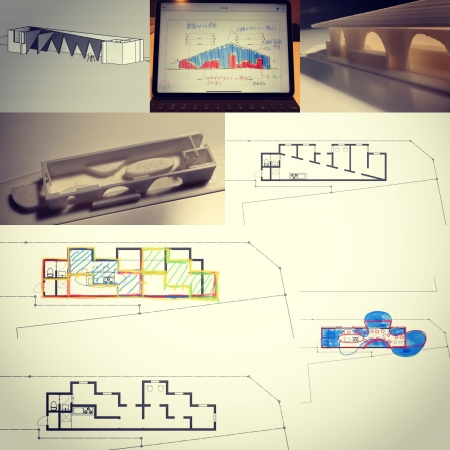自らをコンテクストにする
周りを囲まれた場所ではほとんど何も見えない。何も見えなければ外観は存在しないのも同じである。外壁は存在するが外観にはならない。見えるのは外壁の室内側だけである。
そうなると、外壁も内壁も見た目の区別が無くなる。見えるのは外も内も無く、ただ『壁』だけである。
建築的には外壁と内壁は区別される。外壁は雨露をしのぎ、断熱性が求められ、内壁には無い機能がプラスされ、見た目にも外壁と内壁は違いが出る。時には外壁と内壁の違いが今いる場所の手掛かりになる。
そうなると、今度は外壁と内壁の違いが無いことをコンテクストにする。
外壁と内壁の違いは周りの環境のコンテクストを表しているので、外壁と内壁の違いが無いことはもはや参照すべき周りの環境のコンテクストが無いことと同じである。
したがって、自らの外壁と内壁の違いが無いことをコンテクストとして空間を組み立てるしかなくなる。
"Make yourself a context"
Almost nothing can be seen in the surrounding area. It is the same that the appearance does not exist if nothing is seen. The outer wall exists, but it does not look like it. Only the indoor side of the outer wall can be seen.
In that case, there is no distinction between the appearance of the outer wall and the inner wall. There is no outside or inside, only the "wall".
Architecturally, the outer wall and the inner wall are distinguished. The outer wall is required to withstand rain and dew, and has a function that the inner wall does not have, and the outer wall and the inner wall are different in appearance. Sometimes the difference between the outer and inner walls is a clue as to where you are.
In that case, the context is that there is no difference between the outer wall and the inner wall.
Since the difference between the outer wall and the inner wall represents the context of the surrounding environment, no difference between the outer wall and the inner wall is the same as no longer having the context of the surrounding environment to be referred to.
Therefore, there is no choice but to assemble the space with the context that there is no difference between its own outer wall and inner wall.


